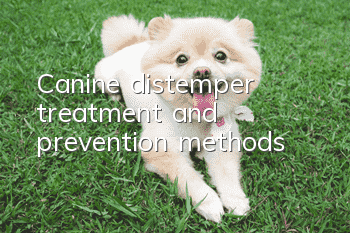Canine distemper treatment and prevention methods

Whether canine distemper virus can be transmitted to humans is a question that many dog owners are concerned about. Many people think of canine distemper and rabies together and think that rabies and canine distemper can be transmitted to humans. In fact, canine distemper and rabies are still related. The difference is that natural canine distemper cannot be as violent as rabies. Whether canine distemper can infect humans depends on the specific evidence. Let’s take a look at the answers from relevant professionals and the treatment methods for canine distemper.
Baidu knows enthusiastic netizens: Canine distemper will not infect humans, but it will pass through various secretions and excretions of sick dogs (nasal juice, saliva, tears, pericardial fluid, pleural effusion, ascites and urine) as well as blood, cerebrospinal fluid, lymph nodes, Organs such as the liver, spleen, and spinal cord contain large amounts of viruses, and they can be excreted to the outside world along with respiratory secretions and urine. Respiratory or digestive tract infection occurs when healthy dogs come into direct contact with sick dogs or through contaminated air or food. In addition to puppies being the most susceptible to infection, foxes and minks among fur animals are also very susceptible to canine distemper.
1. Introduction to canine distemper
Canine distemper must be treated by a doctor as soon as possible. If you are unfortunately infected with the virus, immune serum and antibacterial drugs can be used in the early stages of the disease to cure it completely. Whether you are hospitalized or treated at home, you need to prepare a warm and dry environment for it. The most important thing is that your dog should be vaccinated when it is a puppy, avoid going out during epidemics, and never come into contact with sick dogs and their excrement and vomitus.
There is currently no effective drug treatment for this disease. When sick dogs show obvious symptoms, the prognosis is often poor. Even if a few sick dogs survive, they often have sequelae. In general, specific and symptomatic treatments are adopted to prevent secondary infections and reduce deaths. In the early stage of the disease, subcutaneous or intramuscular injection of anti-canine distemper hyperimmune serum can achieve better results. Serum dosage is 2-3ml per kilogram of body weight, applied continuously for 2-3 days. To control secondary infections, broad-spectrum antibiotics can be used, such as kanamycin, erythromycin, chloramphenicol, gentamicin, etc. To improve circulation and prevent dehydration, glucose solution and electrolytes should be supplied in large quantities. Combined with anti-inflammatory and antipyretic drugs. At the same time, cardiotonic, diuretic, and hemostatic drugs are used for comprehensive treatment. In order to protect the gastrointestinal tract, tannic acid protein and bismuth subnitrate can also be taken orally.
Canine distemper is a common highly contagious viral infectious disease, mainly caused by respiratory tract infection. The fatality rate is very high, and treatment becomes difficult in the middle and late stages of the disease. Nowadays, serum antibody treatment generally has a certain effect in the early stage of the disease, but the effect is very poor once it reaches the middle and late stages of the disease. Therefore, I think there is no need for you to use serum, infusion therapy, and large doses of antibiotics, sedatives, and antiviral drugs now. In addition, you need to strengthen your care. Use antibiotic eye drops in your eyes and some antibiotics in your nose to keep it moist.
2. Canine distemper prevention and treatment methods
1. Canine distemper must be prevented and vaccination work must be done.
2. Carry out disinfection and isolation work to prevent the spread of the epidemic.
3. In the early stage, a large amount of hyperimmune serum, immunoglobulin, strong dog health, interferon, monoclonal antibodies, etc. should be used to prepare emergency passive immunization.
4. Symptomatic treatment: Use anti-infection, anti-virus, and anti-shock drugs in the early stage: such as ampicillin sodium, cefazolin sodium, minor doxorubicin, kanamycin, Canubicang, ribavirin, Shuanghuanglian, Qingxiang Kailing, Weibang, Libang, Pet All Disease Elimination, Chuanhuning, dexamethasone, muscle liver, coenzyme A and vitamins, rehydration and other drugs. Give intramuscular or intravenous injection. (The dosage is determined based on body weight and drug instructions.)
5. Blood transfusion: Take the whole blood of a dog that has recovered from canine distemper and transfuse it intravenously into the affected dog. (The blood types must be consistent.) Blood transfusion therapy is adopted in the early and middle stages of the disease, combined with infusion and anti-infective treatment, and the cure rate is relatively high. In the later stages of canine distemper, dehydration is severe and the body is in a state of exhaustion. Blood transfusion, cardiac stimulation, and rehydration are required in a timely manner. Oral rehydration can also save the patient.
6. In the late stage of canine distemper, neurological symptoms appear, and the above treatment methods are often ineffective. The traditional Chinese medicine "Wenling Decoction" (Canine Distemper No. 2) Antelope Horn Injection, Niuhuang Angong Pills and other medicines must be used.
7. Acupuncture: It is best to use Tianmen, Renzhong, Mingmen, Taodao, Dazhui and other points. Now is the peak season for canine distemper epidemics, and more dogs come to see doctors. The method of combining traditional Chinese and Western medicine is used to prevent and treat canine distemper, and has achieved ideal results.
- How to tell if a dog has a fever? Dog fever and how to treat it!
- Why is the dog licking the ground?
- What does it mean when a dog keeps staring at its owner?
- Puppy loses appetite and refuses to eat after a few bites
- How to feed a dog during pregnancy?
- Four major dog skin disease prevention tips
- Are dogs who often "lick their noses" just cute?
- How to protect Teddy dog’s food? A must-read for dog owners!
- Why is the female Teddy dog infertile for many years? It may be caused by these reasons!
- What causes bleeding in dogs?



